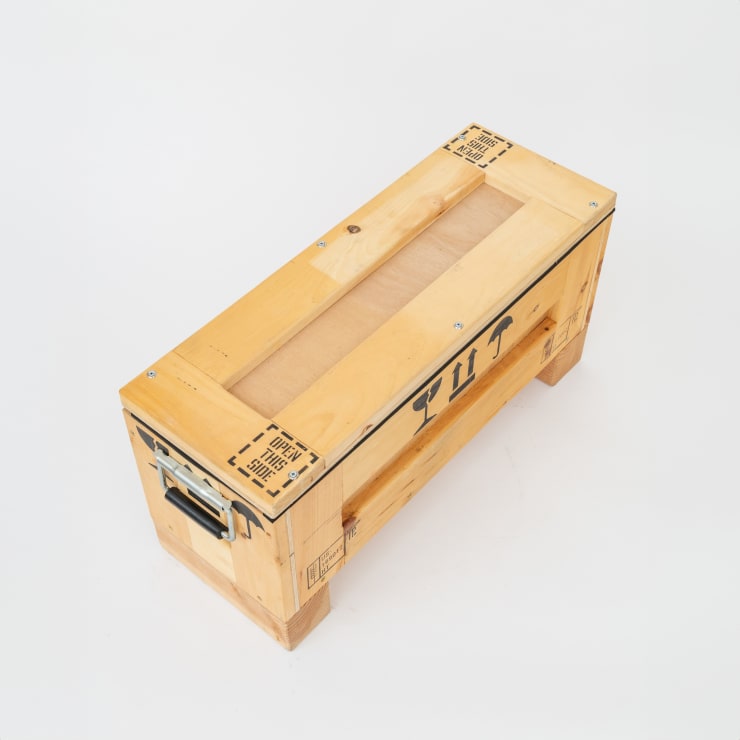CHART is pleased to present Projection 010: Game Transfer Phenomena, an installation devised by the estate of Joshua Caleb Weibley in collaboration with Jordan Dykstra.
Game Transfer Phenomena consists of 7 crates made to hold objects derived from Tetris’s 7 Tetromino shapes. The installation takes its name from repetitive gameplay’s influence on spatial reasoning and the visual/auditory hallucinations it induces. These perceptual occurrences were first observed following the wider release of Tetris during the late 1980s and are also called “The Tetris Effect.”
GTP shapes how one sizes up and evaluates the world similarly to the way commercial and critical art worlds do when one is immersed in them long enough. It is a subtle alteration of perception such that congruent forms — like sofas 69’d into the back of a moving van — reveal themselves and imagined sound effects seem to reward achievement. The exhibition employs GTP as a multivalent metaphor weaving shipping and storage logistics with desperate contortions under systemic duress. The crates are shown open and closed, empty and full, hiding or divulging their cargo.
Incredibly, Tetris’s essential objectives and logic evade easy parallels to potentially harmful behavioral reprogramming. The game even has clinically tested palliative use in the treatment of Post Traumatic Stress Disorder. Counter to the heated global bidding war for licensing that erupted around its 1985 invention (and the countless millions Tetris™ would go on to make), accumulation is anathema to its communistic, centrally-planned economy. Equitably distributing resources is how you win, while hoarding — perhaps squirreling things away invisibly at freeports around the world — is how you lose.
Composer and sound artist Jordan Dykstra succeeds Tetris’s iconic Gameboy soundtrack with a score for the installation mimicking the benefits of Tetris-play for alleviating PTSD. Inspired by the practice of Eye Movement Desensitization and Reprocessing, Dykstra’s composition allows listeners a meditative envelope for reconditioning painful memories. His walking-pace metronomic elements direct tempo through right and left channels at opposite ends of the room, using echo and delay to align or disorient the listener through sections of varying complexity. The piece’s rhythm is made from the sound of crates being struck with a hammer. These strikes stack, collect, become disorganized, and suddenly click together with the satisfaction of removing a row in Tetris over the course of a 12 minute loop.
Repetition, as in a game or a routine, is two-faced. It can dull a thing or hone it. After all: as hard as bad habits cultivated via rote misbehavior are to unlearn, practice also makes perfect.
- Joshua Caleb Weibley, November 6, 2024
Projection 010 is organized by Alex Feim
About the Artist
The estate of Joshua Caleb Weibley was established in 1986 in Peabody, Massachusetts. Citing insurmountable economic, political, and personal factors, active production of artworks by its founder and executor formally ceased in 2024. Having shifted its mission solely to stewardship, the estate authorizes bodies of work for exhibition, as well as overseeing scholarship and conservation efforts. The executor holds a 2009 fine arts degree from the Cooper Union for the Advancement of Science and Art. Work from the estate has been presented by the following venues: 839 Gallery (Los Angeles), The University of Connecticut (Stamford), Veronica (Seattle), TRANSFER (Brooklyn), Resort Gallery (Baltimore), The Ace Hotel (Chicago), King’s Leap (Brooklyn), Klaus von Nichtssagend (New York), Miyako Yoshinaga (New York), Vox Populi (Philadelphia), and Artists Space (New York). The estate’s holdings have been covered in various publications including Makezine, The New York Times, Vice, The Stranger, and Gothamist.
About the Curator
Alex Feim is a researcher, writer, and independent curator based in Brooklyn. Her research and writing focuses on intersections between art and architecture, exhibition context and phenomenology, time based media, and experimental cartographic practice. Her writing has been published in Art Spiel, Battery Journal, and New York Review of Architecture, and she has curated exhibitions at Thomas VanDyke Gallery, Field of Play, and Morris Adjmi Architects. She received her BA in Art History and Comparative Literature from Binghamton University as well as her MA in Art History from Binghamton University.
-
 the estate of Joshua Caleb Weibley, Z, 2023
the estate of Joshua Caleb Weibley, Z, 2023 -

-

The estate of Joshua Caleb Weibley, I (Close), 2023
-
 the estate of Joshua Caleb Weibley, I, 2023
the estate of Joshua Caleb Weibley, I, 2023 -
 the estate of Joshua Caleb Weibley, J, 2023
the estate of Joshua Caleb Weibley, J, 2023 -

the estate of Joshua Caleb Weibley: J (Open), 2023
-

the estate of Joshua Caleb Weibley: S (Close), 2023
-
 the estate of Joshua Caleb Weibley, S, 2023
the estate of Joshua Caleb Weibley, S, 2023 -

the estate of Joshua Caleb Weibley: O (Close), 2024
-
 the estate of Joshua Caleb Weibley, O, 2024
the estate of Joshua Caleb Weibley, O, 2024 -
 the estate of Joshua Caleb Weibley, T, 2023
the estate of Joshua Caleb Weibley, T, 2023 -

the estate of Joshua Caleb Weibley: T (open), 2023
-
 the estate of Joshua Caleb Weibley, L, 2023
the estate of Joshua Caleb Weibley, L, 2023 -

the estate of Joshua Caleb Weibley: L (open), 2023
















